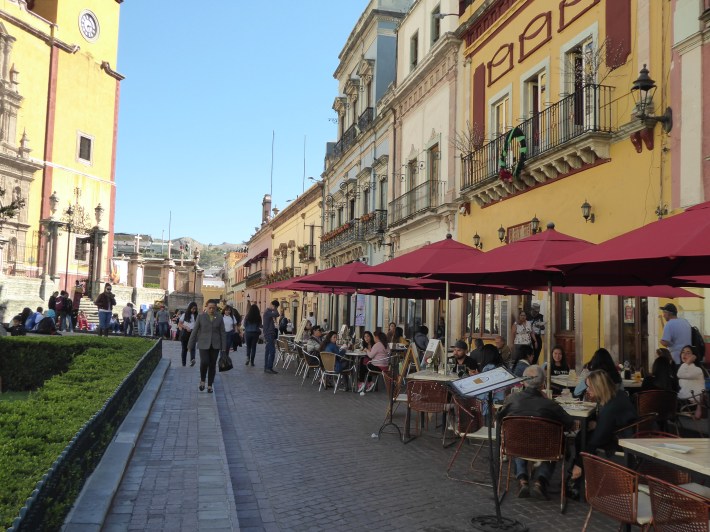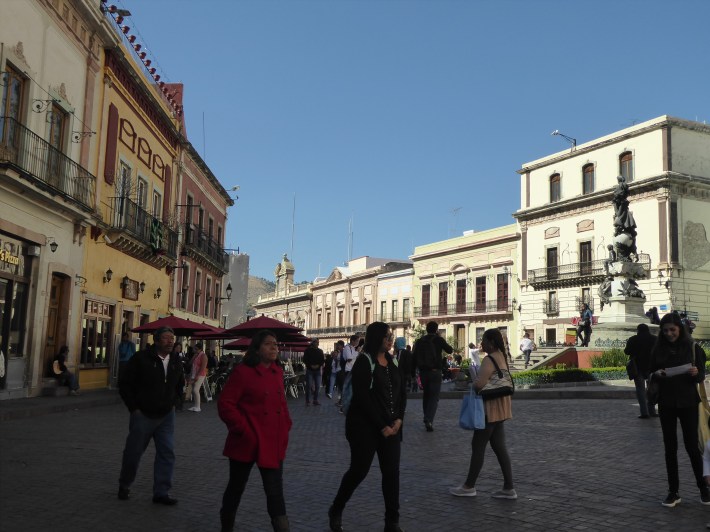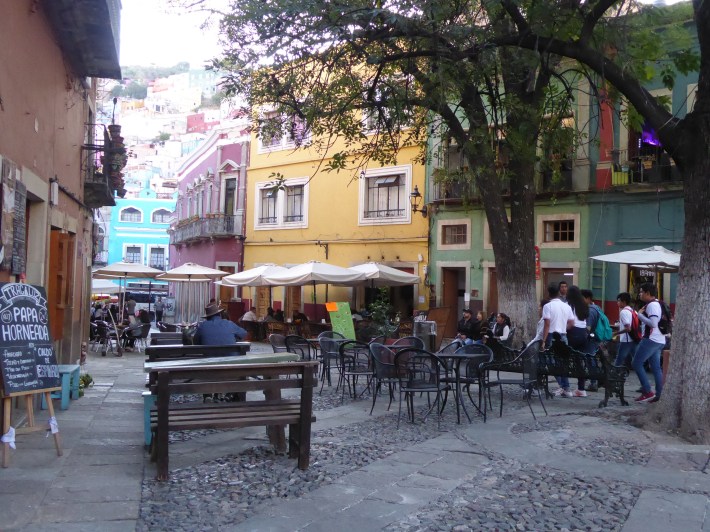
San Miguel De Allende
San Miguel lit up my imagination as soon as I heard of this cobblestoned artistic little gem of a Spanish colonial town years ago. We didn’t have to travel over a continent and ocean to visit a place with so much to offer culturally, historically, and gastronomically. Indeed, there aren’t too many places in North America where one can visit 17th century neo-Gothic basilicas. San Miguel is only a short flight and taxi ride away from where we live in Southern California. After much planning, my family of four, including my 6 and 8-year-old, finally made it there Thanksgiving week of 2017. The plan was to stay in San Miguel, also taking a day to explore the colonial town of Guanajuato (about an hour away from SM). Both are UNESCO world heritage cities packed with historical charm. We are talking about small, walkable towns with centuries old cathedrals, main squares, and narrow cobblestoned streets.

I had some safety concerns about bringing my young children to Mexico. Just a few months before, the US government had expanded their travel advisory within Mexico. Fortunately, Guanajuato, where San Miguel is located, has no such safety warnings. Unfortunately, we took quite a long route to get there. We didn’t fly into Leon Airport (about an hour and a half drive from San Miguel). We flew into Mexico City, took a very comfortable 3-hour bus journey into the town of Queretaro, and finally an hour’s Uber trip to our lovely home in San Miguel for the week. I was apprehensive about flying to Mexico City. I wasn’t sure how safe the roads would be to San Miguel. Finally, my Spanish is basic conversational (Intermediate Spanish learned in college, and a daily 30 minute Pimsleur course while driving. I hoped people would speak to me slowly and expressively. I was relieved to learn that all my fears were for nothing. It was easy to take our bus from the airport, the trip was really smooth, and the roads were good. The icing on the cake for me was how helpful, kind and approachable the locals were. If my family looked lost, someone would be sure to stop and point us in the right direction. I also felt confident to use my sub par Spanish because the locals were patient with me and didn’t judge my many language slip-up.
We didn’t want to rely on a car while in SM, so we found a wonderful home (through Vrbo.com) which was walking distance to just about everything in town. This was most definitely the best possible choice for our family. For the same price of a hotel, we managed to find a charming three-bedroom house with a roof-top terrace and stunning views! The kids loved having the space to branch out and play, and mom and dad loved all the private spaces where we could slip away from the kids. Once we finally made it to San Miguel, we knew the journey was completely worth the trouble.
San Miguel social life is centered around the main square and cathedral, El Jardin and La Parroquia de San Miguel Arcángel. The plaza is lively, to say the least. There are a myriad of festivals and processions during the year. The citizens of San Miguel seem to find any excuse to organize a celebration of some sort. The Dia de la Revolucion happened during our stay. Area high school bands and cheerleaders paraded around the square attracting quite a crowd. Overlooking the main square, on a second floor balcony, there were homecoming queens greeting those gathered below. The main square was absolutely teeming with people – which was wonderful to experience. The downside of all these festivals are the fireworks and firecrackers going off day and night. Our home was away from the hustle and bustle of the center, yet there were a few nights when we were awakened by fireworks in the middle of the night. My biggest recommendation is to pack earbuds just in case.

View of the Parroquia de San Miguel Arcángel

El Jardin Central Plaza, in front of the Parroquia de San Miguel Arcángel

Beauty queens facing a crowd overlooking El Jardin
The first thing I noticed in both San Miguel and Guanajuato was the bright colors everywhere, the vibrant buildings, the fuchsia bougainvillea, and the multi-colored flags hanging over the narrow streets. A week in these two places made home seem very dull by comparison! What impressed me most was the attention to artistic detail from the gorgeously carved doors (each unique), the potted plants on the windowsills and terraces, or the countless wall murals. Beauty was everywhere.
Where we were staying, the place was filled with art and decor from San Miguel and the surrounding area. It inspired us to go out and shop for a beautiful Talavera (tiled) mirror made locally. We found the perfect one at the Mercado de Artesanías between Hidalgo and Colegio streets. The vendors let us bargain a bit, but the refreshing thing was that they tended to give fair prices to start off with. We never felt taken advantage of and never made use of our heavy duty bargaining skills we had learned while living in China. If you find a lovely piece of art or decor you want to take on your flight back home, you can have it securely wrapped and packed at one of the many post offices in the city for a reasonable price.








Templo de la Salud
We were fortunate to have stayed fairly close to the Parque Benito Juarez, a large green space with walking paths lined with trees, lovely benches for people watching, basketball courts, and perfect for us, a playground to keep the kids busy. We spent quite a lot of time there. My husband found someone selling a soccer ball, as well as other children eager to kick a ball around. My kids really enjoyed playing soccer there.
By accident, we happened upon some steps on one corner of the park. These steps took us high above the town and to a lookout point with the most incredible views of all San Miguel. Later we learned that this is Called El Paseo del Chorro. It was approaching sunset when we were climbing up. Almost at the top of the steps, we arrived at a beautiful chapel (La capilla de la Santa Cruz del Chorro. I went inside and sat down for a few minutes. Honestly, this would be a perfect location for a small wedding. Once I came out, the chapel caretaker rang the church bells. Taking in the views and listening to the church bells made it a magical moment. Once we made it to the top of the steps, we took a left and walked another 100 meters to the lookout point. The colors of the town at sunset were just incredible.
San Miguel is the perfect size to walk absolutely everywhere. Just keep in mind to wear comfortable flat shoes. The cobblestones and hilly streets make it tough for women in heels. In addition, San Miguel’s altitude is above 6,000 ft! None of us were affected, but some might be sensitive to it.

Sunset from midway up the Paseo del Chorro steps

The beautiful and serene La capilla de la Santa Cruz del Chorro





View of San Miguel de Allende, with Las Monjas Church (left) and La parroquia de San Miguel Arcángel (right)

Church of San Francisco

My favorite restaurants and cafes:
There’s a lot to choose from in SM. There’s something for every taste and wallet, from little hole-in-the-wall taco shops to luxurious roof-top restaurants with magnificent views. This is another reason why expats and tourists find San Miguel so appealing. Here are a few places which I enjoyed and would recommend, but there are plenty of other fabulous places which we didn’t get to try. I would also love to return to San Miguel without the kids, only to experience more of the night life.
Café San Agustín: an ultra buzzing cafe serving churros con chocolate. Ultra busy but worth the wait.
Hecho en Mexico: Very popular restaurant with good Mexican food and an elegant courtyard
La Parada: a Peruvian restaurant rated as one of the best restaurants in the city. I thought the food was wonderful.
Cafe Oso Azul: Best for breakfast/brunch. Good coffee and a lovely courtyard setting.
Buen Dia Cafe: Good coffee and breakfast and interesting art on the walls. Lovely outdoor terrace seating in the back.
Lavanda Cafe: small cafe with good coffee. The barista takes a lot of pride in his craft. Freshly squeezed juice and good food. There is often a line to get in because this place is quite small.
Guanajuato

I felt somewhat guilty we only dedicated one day to explore this other beautiful and unique colonial town. We woke early one morning and ordered an Uber to take us to Guanajuato. The driver dropped us off in the center of town. It couldn’t have been easier. I knew it would be a charming place, but it really exceeded my expectations. The first thing I noticed, like San Miguel, was the incredibly vibrant and varied building colors. Unlike San Miguel, Guanajuato felt more compressed, with homes built along steep hillsides, almost on top of each other. It also felt more like an authentic Mexican town where locals lived, went to school and worked. It definitely had a youthful feel, as the University of Guanajuato is located right in the center of the city. A substantial portion of the population are students. This may be the reason why there are so many lovely outdoor cafes everywhere. Outdoor life was absolutely buzzing. It was not at all touristy like San Miguel; indeed, few tourists ever make it to Guanajuato. What I liked most is that it’s a walking city. The city was founded in the 16th Century, so the streets were designed for horses, not cars. Cars have a tough time navigating through its narrow streets, and many of the streets are car-free. It has a European feel, with wide pedestrian thoroughfares and squares lined with cafes.
We were also able to find quite a few landmarks in the city by just walking around and stumbling into them. It’s hard not to miss the enormous Hidalgo Market (Mercado), located on the Avenida Juarez. It was built in 1910 and has two stories of vendors selling everything from arts and crafts to meat and produce to prepared foods. We came across the Rivera Museum while walking down Positos Street. This was the one-time home and birthplace of the famous and legendary Diejo Rivera. The first floor of this museum has been recreated to look as it did at the time when Rivera lived there. The upper floors hold some of his art pieces (original and reprints). Right off the lovely Plaza Los Angeles, we discovered a line of couples waiting to have their pictures taken up a very narrow and steep set of steps flanked by houses with balconies on both sides. It was so narrow that one could reach out and touch the houses on either side. We had discovered the famous El Callejon del Beso (The Alley of the Kiss). There is a tragic and famous love story behind this place where two lovers shared kisses across the narrow alley. It was an absolute joy to just walk aimlessly and discover the many beautiful and pedestrian friendly plazas in the city. My favorite was the enclosed Plaza de San Fernando. It felt very European, with many outdoor cafes. My kids enjoyed running after the pigeons there. The Plaza de la Paz felt like the center of town. Its main feature is the beautiful Basilica Colegiata de Nuestra Señora de Guanajuato, built in the 17th century. It’s a busy and bustling plaza and a great place to people watch while sitting at one of the cafes.
Just as the sun was setting, we ordered another Uber to take us back to San Miguel de Allende. Guanajuato had intrigued me enough to make me want to see and experience more, so I’ll have to figure out a way to come back.


Plaza de Los Angeles

Diego Rivera Museum


Plaza de La Paz

Plaza de La Paz

Templo de San Diego de Alcala


Charming Plaza de San Fernando
